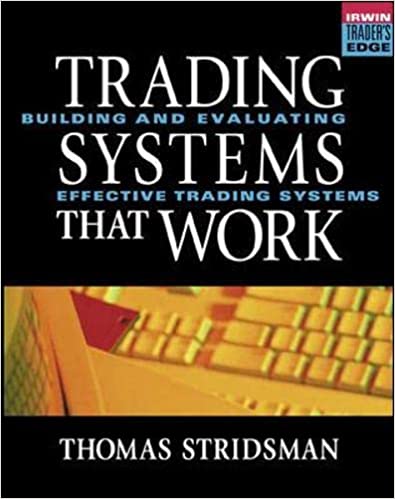Trading Books: ‘Trading Systems That Work’
Author: Thomas Stridsman
Publisher: McGraw Hill
Year: 2000
Book Review Rating:
**** Recommended
Topics Covered:
- Trading Systems
- Trading System Profitability
- Trading System Performance
- Trading Strategies
- Entry Signals
- Exit Signals
- Filters
- Trading System Development
- Trend Trading Systems / Trend Following Systems
- Position Size
- Risk Management
- Back Testing Trading Systems
- Drawdown
- MAE (Maximum Adverse Excursion)
- MFE (Maximum Favourable Excursion)
- Portfolio Composition
- Out of sample testing
Click the image below to buy it now on Amazon:
Trading Book Review of ‘Trading Systems That Work’ by Thomas Stridsman
I recommend ‘Trading Systems That Work’ to people who need to learn about trading system development. Thomas Stridsman is a recognised expert on trading systems and his trading books are well worth reading if you are interested in systematic trading.
Today’s book review is about “Trading Systems That Work” by Thomas Stridsman. Now what’s really great about this book is it takes a reader through the entire journey from concept to optimization and completion of a trading system. This trading book does a really great job of explaining how they measure the performance of a trading system. Then once you understand how to measure the performance of a trading system it gives you some of the key building blocks that you can use to piece together a system that will meet your objectives.
From there the book goes on to talk about how to improve your trading system by filtering to eliminate some of the bad trades or eliminate the market conditions that your system is not suitable for, because not all trading systems work in all market conditions. You need some rules, some criteria in your trading system to make sure that your trading system is only active when it’s really going to be profitable. The book does a good job of showing you how to do that.
Then finally it takes you through how to take the trading system that you’ve built and overlay position sizing and portfolio management and portfolio selection. It explains how to choose exactly which instruments to trade or which combination of instruments to trade. It takes all of those things and puts them together to show you how to build a trading system with a portfolio and risk control and position sizing.
Now that’s no mean feat, it does take a little bit of effort to get through, but once you’ve read this book you will understand the basics of going from the very beginning of the concept of a trading system through to designing the rules, through to testing and optimizing them, and then improving them with things like filters and the right position sizing and the right risk management on top of the system.
One of the things that I struggled with in the book though was that all of the examples are given in TradeStation Code. TradeStation is a platform for doing back testing and designing trading systems. But I don’t use that system – I use a number of different systems to test my trading strategies and trading systems. So I had to do a little bit of translation every time I wanted to use one of Stridsman’s ideas or concepts and try it on my own systems.
Now it’s not the end of the world, TradeStation Code is pretty easy to read if you’re in any way mathematical or logical in the way you decipher things, but it’s just that little extra bit of effort that I probably could’ve done without. I would’ve much preferred to see some generic logic statements to explain the code and then maybe the TradeStation Code in the back, in an appendix. Having said that there’s still a huge amount of value in the book so don’t let that detract you from looking into it.
One of the key insights that I’ve got from the book was that you really need to size your trades conservatively because freak occurrences do happen. Stridsman talks about what happens when you get a trade which loses far more than you expect to lose and how that can impact your portfolio. Now that for me was a critical insight and it’s really saved me on a bunch of occasions where something bad’s happened with the instrument that I was trading. If I had been sizing too aggressively it would’ve really damaged the account.
But when you get your position sizing right and when your risk levels are low and contained then you really can survive those things. That’s what trading success is all about, surviving through the downside so that you can benefit from the upside that your system will generate in the long term.
I gave the book four out of five. It’s one of my favourite trading books and it certainly paved the way for a lot of trading success for me. It helped me be clear about trading system design. The concepts I have used since then have made me a lot of money.
I recommend it – If you haven’t read any of Stridsman’s books try this one out and let me know how you go.
If you haven’t already please click below and download my free special report which is the “Top 10 Lessons I Learned by Reading 150 Trading Books”. Just the 10 lessons in that report alone could save you years off your learning curve and thousands and thousands of dollars. If you’re at all like me, if you’re all like most new traders there’s several classic mistakes that you make which you could avoid as soon as you’re aware of them.
Download the report – It’s a free download and it will be delivered to inbox instantly and let me know what you think about it.
Also please write me a comment about this video if you have any questions, please do that and I’ll get back to you personally.
Thanks very much – Bye for now.










Magnificent site. Plenty of helpful information here.
I am sending it to several friends ans additionally sharing in delicious.
And naturally, thank you in your effort!
Thank you for taking the time to read my articles Vioaj – Make sure you check out the free resources and training I have available here: Link